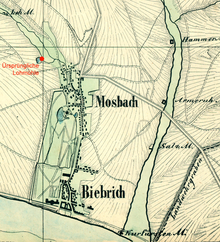Chemical works Albert

The Chemical Works H. & E. Albert was 1858 in Biebrich by Heinrich Albert as Agriculture Chemical and glue factory founded.
founding
In 1858 Albert found a suitable location for his fertilizer factory, an old lease mill in the Mosbach valley north of Mosbach near Biebrich. There he began in October 1858 with the production of fertilizer from slaughterhouse waste containing phosphate and nitrogen . In 1859 his brother Eugen Albert joined the company as commercial manager. In search of a new location for the expanding company, the company moved to neighboring Amöneburg , then Hesse-Darmstadt , because the Nassau administration refused to grant it the license to set up a chemical factory in Biebrich. A chemical operation at the residence of the Dukes of Nassau seemed unacceptable at the time.
The company achieved European and finally worldwide importance through the development of double superphosphate in 1871. In 1884, the production of Thomas flour (English: "Albert Slag") from phosphate slag from blast furnace processes began. The company was renamed “Chemische Werke vorm. H. & E. Albert Aktiengesellschaft ”. Up to the First World War there were also plants in England , Belgium , France , Luxembourg (Thomasschlackenmühle next to the Arbed plant in Esch-Schifflange, from 1912 until shortly after the end of the First World War) and Russia , which, however, were confiscated in the course of reparations payments after 1918 . As blast furnace slag was increasingly being marketed by the smelters themselves, the production of pharmaceuticals began in 1922 .
Merger into a family company
In 1940 Chemische Werke Albert AG merged with Chemische Fabriken Dr. founded in 1909 by the youngest son Kurt Albert . Kurt Albert GmbH in Amöneburg. The latter held the first patents in the field of phenolic resins ( Albertols ) through Ludwig Berend .
After the factories in Amöneburg had been largely destroyed in a bombing raid in 1944, the reconstruction focused on the additional production branch of pesticides, the production of which was discontinued in 1961. In 1964, Hoechst AG took over the majority of the shares. For the synthetic resin sector, Albert took over Reichhold AG, formerly Beckacite, in Hamburg-Wandsbek in 1967 and merged it to form Reichold-Albert-Chemie AG (RACAG). In 1969, Albert-Roussel-Pharma was founded as a sales company for the pharmaceutical sector.
After being taken over by Hoechst
In 1972 Reichhold-Albert-Chemie AG was incorporated into the Hoechst Group and in 1974 renamed Hoechst AG, Werk Albert and Hoechst AG, Werk Hamburg . The Albert work was in 1989 with the from the chemical factory Kalle in Biebrich emerged, directly adjacent, work Kalle to work Kalle-Albert merged.
In 1995 Hoechst AG split into a strategic management holding company. In 1995 Hoechst outsourced its synthetic resin business as Vianova Resins , which was taken over in 1999 by an investment bank consortium led by Deutsche Bank and Morgan Grenfell Equity Partners, in 2000 by Solutia , in 2003 by Union Chimique Belge and most recently in 2005 by Cytec . In 2012, Cytec sold the coating division again to the private equity fund Advent International , which has had the company name Allnex since mid-2014 .
The Kalle-Albert plant is now located in the Kalle-Albert industrial park , where around 80 companies are located.
In October 2000, a major fire destroyed a large synthetic resin factory at the old Albert factory.
Individual evidence
- ↑ sehenswertes-biebrich.de: The Lohmühle.
- ^ Brigitte Streich : Wiesbaden - the way from the spa town to the economic center. Business location Wiesbaden, Darmstadt 2003/2004. Pp. 114-125
- ^ Antje Hagen: German direct investments in Great Britain, 1871-1918. at Google Books . P. 69f
- ↑ Allnex: Cytec Coating Resins Establishes Exciting New Identity as Allnex. Retrieved September 8, 2015. (English)
- ↑ Wiesbaden-Biebrich volunteer fire brigade: Major fire in a Wiesbaden chemical plant - explosion transforms resin factory into a sea of flames. ( Memento of the original from February 26, 2013 in the Internet Archive ) Info: The archive link was inserted automatically and has not yet been checked. Please check the original and archive link according to the instructions and then remove this notice. Article of October 14, 2000 in the Wiesbadener Tagblatt
literature
- To celebrate the 50th anniversary of the company H. & E. Albert, later Aktien-Gesellschaft Chemische Werke vorm. H. & E. Albert in Amöneburg near Biebrich a. Rhine 1858–1908. Biebrich 1908.
- Frithjof Kroemer: Eighty Years of Chemische Werke Albert 1858–1938. Frankfurt am Main 1938.
- 100 years of chemical works Albert. Anniversary publication, Wiesbaden-Biebrich 1958.
- Ernst Schwenk: 125 years of Albert Chemie in Biebrich on the Rhine. Pictures and facts about the company's history. Wiesbaden 1983.
Web links
- Early documents and newspaper articles on Chemische Werke Albert in the 20th century press kit of the ZBW - Leibniz Information Center for Economics .
Coordinates: 50 ° 2 ′ 2.3 ″ N , 8 ° 15 ′ 4.7 ″ E


